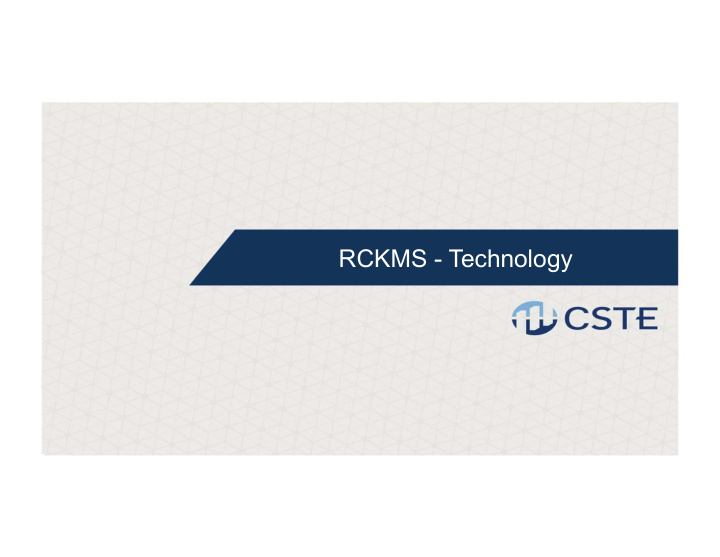



RCKMS - Technology
The Thinking Behind RCKMS Software Build a software suite based on an open source software, best practices, and standards‐ based principles, incorporating the following components: 1. General‐purpose Public Health Decision Support Service (PH‐DSS) for processing ongoing, real‐time requests that can determine whether or not a case report should be sent to Public Health based on the medical record information supplied to the service. (The DSS bases these decisions on the executable reporting specifications created in the Authoring Tool) 2. Easy‐to‐use Authoring Tool to assist jurisdictions in conceptualizing, creating, maintaining and deploying machine‐executable reporting specifications (for each desired condition) to the DSS service. Authoring tool should be generalizable so it can evolve with authoring requirements and runtime environments 3. Integrated with the Public Health Community Platform (PHCP), or option to run on its own
RCKMS Public Health Decision Support Service • PH‐DSS built atop the OpenCDS o Freely available Clinical Decision Support (CDS) software: “multi‐institutional, collaborative effort to develop scalable, CDS tools and resources” o Facilitate widespread availability of advanced CDS capabilities through collaborative development of standards‐based DSS infrastructure and tooling o Open Source o Active collaboration by RCKMS team • Lower barriers to adoption; foster interoperability between public health and other clinical systems o HL7 Decision Support Service Standard for standard functionality and interfaces o HL7 Virtual Medical Record (vMR) for consistent modeling of the rules o HL7 Clinical Quality Language (CQL) and Drools as executable representation of rules o Evolve to future models and payloads (e.g. FHIR) if needed
Characteristics of the RCKMS PH-DSS • Web Service architecture • Scalable by volume of requests and by number of jurisdictions/conditions • Conducive for future enhancements o Accessibility to Authoring Tool data o Support of different payloads • Evaluates patient data (input) on a request‐by‐request basis o Determines (or requestor may specify) which jurisdictions are relevant based on patient’s address, where the patient received care, and/or servicing laboratory o Executes the relevant reporting specifications for those jurisdictions • Outputs o Notice of Reportability (NoR) for each jurisdiction o Specifies list of conditions reportable to the jurisdiction: for each condition, where to report, and timeframe to submit case report
RCKMS Authoring Tool • Built atop the CDS Administration Tool (“CAT”) o Open source framework and application for managing CDS logic and deployments o Terminology/concept management, authoring & deployment of rules, and automated test case creation o Includes a web (UI) front end • Simplifies authoring of reporting specifications o Two user views: RCKMS Administrator view, Jurisdiction view o Reporting specifications data entry simplified via grid format o Generated rules in a standards‐based output o Ability to generate a “human‐readable” view of any reporting specification
How the Authoring Tool works RCKMS Tool Reporting Criteria Decision Authoring Pertussis Support Interface Repository PH Pre-populated with Service criteria for pertussis 1. Jurisdiction enters reporting criteria into authoring interface (website) - RCKMS tool comes pre-populated with default reporting criteria that users can choose to use, or customize to meet their jurisdictional needs 2. Information entered → stored in repository → Linked to decision support service 3. Jurisdiction can test whether criteria entered correctly by using test manager
Preconfigured Defaults for Each Condition (“out-of-the-box”) • Users may adopt reporting specifications “as is”, or modify them o Users may simply accept the default rules for each condition if they wish o To modify defaults, select preconfigured “Criteria” to add or remove o If additional criteria desired, contact RCKMS team • If Value Sets change, Authoring Tool and PH‐DSS automatically accounts for changes • If guidelines/logic change, RCKMS team updates Authoring Tool with new default rule logic and publishes new default rules; jurisdiction incorporate into local version
Default Reporting Specification (Chlamydia)
RCKMS Test Cases • Test reporting specification logic under varying conditions to ensure correct operation • Automated testing: run all tests at once or individually • Accepts eICR file imports or manually entered tests • User enters: o Test (sample) patient data inputs Expected outputs: o Reportable: Yes/No List of Criteria met • Outputs: o Test pass/fail Conditions that are reportable o List of Criteria met o
Test Case Editor
Deployment of Reporting Specification to PH-DSS • Scheduled or On‐Demand • Deployed via REST service invocation to OpenCDS • Concepts and Mappings deployed to PH‐DSS (value sets, individual code system codes, and concepts) • Intermediate representation of the rules as HL7 CQL Expression Logical Model (ELM) format (XML) o Standards‐based, technology‐agnostic, sharable representation o Facilitates additional verification of the rules, race condition checks • Final executable representation of rules as Drools
RCKMS Administrator-Only Configuration Functions
RCKMS Administrator-Only Criteria Authoring
Recommend
More recommend